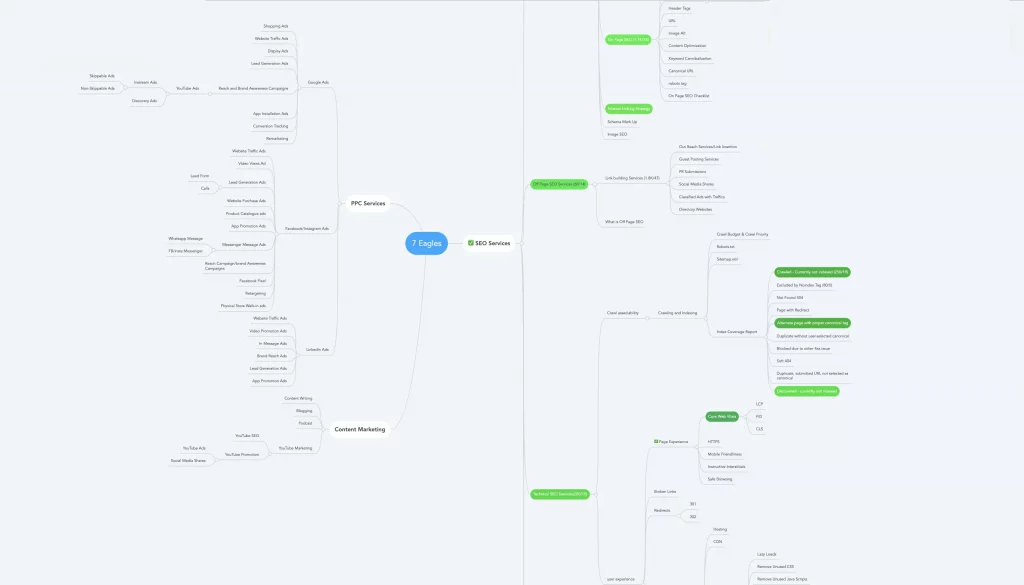What Is Website Architecture?
The structural planning of web pages, links, visual appearance, and functional interface for a website is referred to as website architecture.
An ideal site architecture makes it simple for users and search engine crawlers to discover new web pages.
Any website’s technical, functional, and aesthetic elements are planned for its architecture before design and development. It is a tool used by SEO webmasters and designers to build websites.
Website architecture is used to layout a website logically and follows the business requirements.
The following are a few elements of website architecture:
- Technical limitations, including those related to servers, storage, memory, and communication interfaces.
- The kind of services or procedures the website will offer are functional features.
- A user interface, colors, buttons, and other visual design elements make up the visual appearance.
- Security specifications, or how the website will make sure that transactions and access are secure.

Why Is Website Architecture Important in SEO?
There are numerous benefits behind planning site architecture and developing them accordingly.
Architecture planning is crucial to on-page and technical SEO to build quality content with the topical authority and crawl accessibility.
Here are a few benefits of website architecture that could improve your website’s organic position.
Site Architecture helps in Internal Linking Strategy:
- Internal linking is the process of linking internal web pages.
- It helps visitors and search engines navigate your website’s relevant web pages to find the information they’re looking for.
- This keeps them spending more time on the website and scrolling down through multiple web pages.
- Crawlers discover new web pages with the help of internal links from indexed to new ones. So, this helps increase the crawl budget and accessibility.
- Internal links help transfer authority, link juice from one page to another, and build trustworthiness.
Improves Crawl Accessibility
- Crawlers that crawl your website will benefit from a well-built structure with solid internal linking because it will make it easier for them to find key content.
- The ability of search engine bots to discover and read the content of your website is known as crawling. An improper website architecture planning could affect crawl accessibility, and many web pages might exclude from crawling.
- When the website is built with proper planning, there will not be any wastage of the crawl budget.
- Yet, the crawler can discover various web pages from all dimensions of categories and depth.
Easy Navigation over Website:
- Maintain consistency: Consistent navigation on your website makes it easier for users to navigate and makes it easier for visitors to discover the content they’re looking for.
- Clearly define categories: The categories in your menu must be distinct aesthetically, whether it has several sections, categories, or subcategories.
- In other words, even if the categories are links, the category titles and the subcategories must be visually distinct.
- Make all links in the navigational components clickable: All heading components should be clickable links when your navigation contains several categorized divisions.
- This is still true even with drop-down menus, where a visitor may naturally be drawn to clicking a subcategory link.
- Use precise navigation headings: Before clicking any navigational links, visitors should clearly know what they should find on a page. Whether the link is an internal text link or a major navigation link holds.
- To ensure visitors understand what they will receive, use precise words to explain the linked page.
Helps to Build Topical Authority Contents:
- Writing a high-quality, SEO-optimized article isn’t always enough.
- Even providing a valuable resource for readers may not be enough to outrank your competition in the SERP.
- Google loves any website with topical authority on a specific topic in the niche. As it acts like an expertise in that topic or niche.
- A topical authority is when you have the breadth of content on your website related to a particular topic or niche within your industry.
- It is one of the ways Google assesses the perceived quality of your website’s content and a ranking factor for top-level domains.
- Building topical authority can help you rank higher in various related articles, but it does not always directly correlate to increasing page rank.
- When you demonstrate to search engines that your website is a comprehensive resource for a specific area of search interest, they will be more likely to boost your overall rankings.
- As you build out topical content, search engines will see users engaging with your domain as a go-to resource for your chosen topic.
- Website architecture along with planning helps to identify the gaps in forming a topical authority website.
Helps form Pillar and Cluster Web Pages:
- A pillar page is a collection of individual landing pages or hub pages covering a specific topic. It is vast and to-the-point, establishing authority on the central subject matter.
- A pillar page provides space to build rich supporting sources, such as blogs, guides, and more, that aim to educate the readers while building authority in terms of concept.
- These dots on the pillar page are linked to various landing pages on your site, and link building is what connects them.
- In a hub-and-spoke model, topic clusters are groups of related content that are tightly organized around a core topic.
- When you form a website architecture with mind mapping, you can create a cluster of topic around pillar topics.
Helps in Creating Sub-Directories (Categories):
- Subdirectories or subcategories are website hierarchies that exist beneath a root domain and organize websites.
- When it comes to SEO, using subdirectories over subdomains has several advantages.
- Your primary site may be crawled more frequently since you add new content and blog posts frequently; therefore, the SEO authority you have will be consolidated.
- Subdirectories will make navigation easier for your site’s users than hopping back and forth between the main site and a subdomain.
- If you have a blog post about new features or products, your users will be able to easily navigate between your blog and your product/service pages.
- So, planning on sub-directories are part of site architecture.
Passes Link Juice and Authority:
- Link juice known as link equity is a ranking factor that describes the authority passed from one website or page to another.
- Link juice is measured in various ways, including the topical relevance of the link, the page authority of the domain from which it is linked.
- Link juice can pass authority in two ways while you build links:
- Internal Links: Hyperlinks that take readers to other pages within the same root domain.
- PageRank was introduced when Google first revealed the algorithm that calculates site rankings in its search results.
- In order to determine rankings, PageRank focused on a site’s backlink profile.
Helps to Prevent Keyword Cannibalization:
- When several pages on a website compete for the same or similar keywords and harm the site’s organic performance, this is known as keyword cannibalization.
- Keyword cannibalization can be found and fixed, but sometimes it’s more effective to avoid the problem at the base stage.
- Develop a strategic site architecture planning; this helps you understand, not work on similar keywords for two or more pages.
How to Plan a Website Architecture?
- Planning and developing the structure for a huge website is not easy. There are a few particular actions that must be taken.
- This post will outline the essential measures you must take to guarantee that the website architecture meets your client’s needs.
- The first stage is making a plan during the website development project’s discovery phase.
- Making a detailed strategy will help you avoid scope creep or unanticipated project scope expansions.
- They term it “project creep” since it frequently happens without warning, and receiving payment for additional labor that was not authorized is challenging.
Understand Your Audience:
- The group of customers or potential customers who currently or in the future need or want your products or services is known as your target audience.
- These individuals are most likely to look for, interact with, and eventually buy your item.
- Examine any recent analytics and data.
- Consider your audience’s past triumphs.
- Establish buyer personas.
- Publish surveys.
- Watch out for your rivals.
- Keep an eye on audience responses, comments, and interactions.
- Try out new updates and content for your products and services.
Find the Seed Keywords:
- Seed words are concise. Usually, they are one or two words without any modifiers. An easy seed keyword would be “SEO Services.” This builds the pillar page for many cluster pages to come.
- It’s common practice to utilize seed keywords to help other keywords flourish. To create a lengthy list of keyword phrases, you might enter a seed term into the
keywords explorer tool on Ahrefs or the keyword magic tool on SEMrush.
A few primary sources can help you choose your seed keywords:
- Terms specifically related to your goods or services
- Words your audience would use
- Related Google search phrases were discovered
- Current content and page rankings
- Competitive terms
Conduct Keywords Research for Cluster Keywords:
- The SEO strategy of a website is considerably enhanced by keyword clustering.
- Search engines now rank pages with semantic keywords rather than single keywords because they are more sophisticated and can understand the context and keyword synonyms.
- With the launch of the Google Hummingbird Algorithm in 2013, Google gradually shifted its emphasis from keywords to subjects and better understood the intent behind a query.
- Additionally, keyword clustering compels businesses or brands to thoroughly analyze their websites and provide more in-depth and detailed content.
- Get a list of keywords and group your keywords here.
- Consider including them in your content.
Do Competitor Research to fill the Gap in Cluster keywords:
- Using this analysis technique, you may identify and fill any gaps in your SEO approach.
- It allows you to find out what keyword opportunities that can be used to build cluster of web pages.
- Recognize your target market and how they search.
- A keyword gap analysis is an important component of keyword research, which in many respects is also competitive research.
- Cluster keywords can build your website architecture with more ideas on building website. This can help your website rank better.
Use Mind mapping Tools to Build Website Hierarchy
- You may believe that a mind map is not essential because you have already used brainstorming techniques and tools. But you might want to try mind mapping instead.
- You’ll be able to change the way that mental processes are taught and enjoy greater freedom and control over your own ideas.
- It offers an organized and thorough structure for the information – When using a mind map, stay away from chaotic, disorganized, and confusing brainstorming tools.
- By providing a hierarchical structure of data and related information, the mind map functions.
- Using a mind map, you can see the big picture and come up with concepts that link to and support the central notion.
- This makes it quite helpful when giving presentations to others and, especially, while looking for answers to challenging challenges.
- Increased creativity you should also exercise your creative mind. You might anticipate feeling exhausted throughout the day if you put your mind to nonstop thinking.
- Since your brain serves as your primary engine, you should do everything in your power to excite it with original ideas.
How to use SEO-friendly Website Architecture?
In search engine optimization, site architecture is the unsung hero. The most important factors affecting whether or not your site can rank for difficult-to-rank, highly competitive keyword phrases are its navigation and URL hierarchy.
Even if your site has the best content in the world, organic search performance will suffer if users or search engines find it difficult to navigate or crawl. Despite being fundamental, it is relatively simple to execute site architecture improperly or, even worse, to neglect it entirely.
Use SEO-friendly URL Structure:
- The user experience and URLs should be similar to those of other websites that are leaders in your industry or specialty.
- Keep in mind that your target audience visits numerous websites. More than you do, most likely.
- Because they fulfill the expectations of their visitors, websites are comparable.
- When you last used the internet to investigate a significant buying choice, the odds are that all of the websites you visited followed a similar structure.
- The URL for each page should grow longer as you move from the homepage to a category page and then farther into the website.
- The keyword phrase that the page should target should be longer than the URL.
Plan your Navigation Menu:
- Your most important pages should be accessible from the home page in three clicks or less, as was previously stated.
- The “three clicks or less” criterion enhances your site’s usability and “crawl ability.”
- Your most important pages should be a click away from your home page. These pages concentrate on keywords with lengths of one to three words.
- The keyword phrase visitors should target should be longer the further they explore the website.
- From the below picture, we can identify how to navigate the users to their destination location.
Use Category Pages:
- Long-term architecture organization on your site is made incredibly simple by category pages.
- If we want to start a brand-new page, we can include it in a current category and, from that category page, link to it.
- If you like to contribute a lot of new pages, then make a new category, and from that new category page, links to the new pages and also perform SEO for category pages, so that you can get more conversions.
- Without categories, pages are added at random, resulting typically in complex site architecture.
- From the below image, we can see the list of pages on our site.
Depth of your Website Pillar Pages:
- Pages shouldn’t be buried deep within your site because a strong website layout should make it simple for users and search engines to find your site’s content.
- Most people expect that all pages should be reachable within three clicks of the homepage of your website, and proper site structure can enable this.
- Breadcrumbs and internal linking can assist in guaranteeing that pages aren’t buried deep within your site, but aiming to maintain information within these three tiers can benefit from visualizing your layout.
- Doing this may prevent your website from having orphan pages, which are ones to which no other pages on your site are linked.
- In essence, it can only be reached through a direct link and cannot be reached from any place on a website.
Create a HTML sitemap (for website 10000+ Web Pages)
- Consider creating an HTML sitemap as the last step in creating a strong website architecture.
- These sitemaps are accessible to users and offer a list of URLs that search engines may crawl, thus lowering the danger of orphan sites and facilitating the speedy discovery of new pages.
- Remember that HTML sitemaps are advised to be in place and that they also distribute PageRank (link authority).
- Don’t undervalue the significance of having the proper website architecture or the effect it can have on your SEO results.
Use Internal Linking Strategy:
- If you’re not familiar with them, internal links are links that lead from one page of your site to another. They are essential to planning an effective site structure.
- Internal links also provide the advantages of passing link authority, assisting users in navigating between sites, and assisting search engines in comprehending the structure of your website and the thematic relationship between pages.
You can internally link using a variety of techniques, such as
- breadcrumbs,
- internal links in context,
- directional connections.
Conclusion:
- Every website should have a solid site architecture that has been established.
- When correctly designed, it guarantees that users and Google will find it simple to crawl your website.
- It ultimately affects the extent to which your long-term SEO efforts will be successful.
- Plan a user- and search engine-friendly structure, divide your pages by subjects, distribute link authority wisely, and make it as easy as possible for people to find the sites they want to peruse.
- Contact our team of professionals for advice if you’re unsure of how changing your website architecture would affect SEO.













